For a general breakdown, check out our diaper size chart before heading to the store. Always consult medical professionals for full diagnosis and treatment. At this stage, your toddler will be constantly on the go, so look for diapers with strong tabs and plenty of stretch. Was this page helpful? The size chart runs a little smaller than others, so this is another one where you'll want to review it carefully before you buy. Develop and improve services. Working with NICU nurses, Pampers created a line of preemie diapers that fit preterm babies of any size. Head circumference in. Measure content performance. You can use a standard bathroom scale and follow these basic steps to weigh your baby:. Newsletter Sign Up. Newborns may use up to 10 diapers per day.
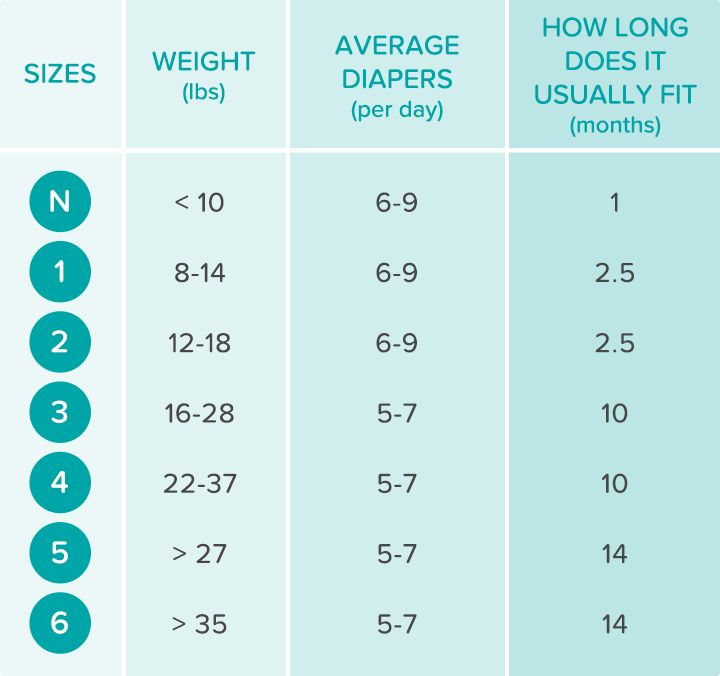

Newborn babies use the smallest diaper sizes, of course. Was this page helpful? If this is the case for you, try using Size 1 and folding down the waist before you put it on. New York: Bantam Books, After fastening the diaper, you should be able to fit two fingers under the waistband. Most babies will start in the Newborn size which also has a cut-out in the front for the umbilical cord then ultimately spend the majority of their diapering days in size 4, the most popular size on the market. On either end of the spectrum, Huggies and Pampers both offer a Preemie size for babies under six pounds, while Pampers even offers size 7 for toddlers over 41 pounds. Parents sometimes complain that Newborn diapers seem too small, yet Size 1 seems too big. Newborn diapers size N.
Diaper Size Guide
You may also want to choose a style with a U-shaped hole cut out to make umbilical cord care easier. Diapers sizes range from Preemie to 6, but like Pampers they'll vary by style. Height in. For babies born between 37 and 40 weeks, birth weight typically ranges from 5 pounds and 8 ounces to 8 pounds and 13 ounces. Use profiles to select personalised advertising. During this age range, your baby may gain about five to seven ounces per week, doubling their birth weight by about 5 months. Though sizes vary from brand to brand, Pampers offers three sizes that suit a wide range of birthweights: size P1 for preemie diapers less than six pounds , size N for newborn diapers less than 10 pounds , and size 1 diapers 8 to 14 pounds. The following signs indicate that it's time to upgrade their fit. Ill-fitting diapers can cause messy leaks, rashes, and discomfort. Also note that the size chart differs slightly from some of the other popular brands, so double check before you buy. Newborns may use up to 10 diapers per day. Related Articles. Diaper needs will change as your baby grows, becomes more active, and approaches different development milestones.
Diaper Size and Weight Chart Guide | Pampers
- Related Articles.
- Size 1 diapers.
- We want to make it easier to find the perfect pampers diaper sizes for your growing baby, and our research resulted in a diaper size and weight chart to guide you in the right direction!
- If a diaper is too big, baby pee and poop may leak out of the gaps before the diaper can absorb it, leading to skin irritation.
Ill-fitting diapers can cause messy leaks, rashes, and discomfort. Newborn babies can produce 10 to 12 dirty diapers each day, which eventually decreases to six to eight diapers during toddlerhood. Given all of that pee and poop , it's vital to find the right fit for your little one. You certainly don't want leakage from a too-loose waistband or too-tight leg holes! But unfortunately for new parents, there's no universal measurement guide for diapers. Sizing varies between each infant—just like it does for clothes and shoes—and it depends on weight instead of age. For a general breakdown, check out our diaper size chart before heading to the store. Over the course of their diaper days, your baby will go through many different sizes. They'll probably start with "Newborn" diapers, which generally accommodate infants up to 10 pounds. Premature babies weighing less than 6 pounds might need "Preemie" diapers, offered by some brands like Huggies. Some parents like a diaper with extra stretch that will accommodate a newborn's rapid growth. You may also want to choose a style with a U-shaped hole cut out to make umbilical cord care easier. Since newborns make small messes and get changed very frequently, absorbency isn't a huge issue. As your baby grows and becomes more active, their diapering needs change. They'll start graduating to different sizes; most brands make diapers in size 1 through size 6. Finding the ideal fit is especially important after starting solids around months since messier diapers require minimal leakage. Indeed, as the size becomes bigger, the diapers will have more absorbent materials, says Tricia Higgins, a spokesperson for Pampers. Most kids remain in diapers until they're between ages 2 and 3. At this stage, your toddler will be constantly on the go, so look for diapers with strong tabs and plenty of stretch.
We've been independently researching and testing products for over years. If you buy through our links, pampers diaper sizes, we may earn a commission. Learn more about our review process. Becoming a new parent pampers diaper sizes be confusing enough; the last thing you should worry about is deciphering a diaper size chart to figure out which ones to stock up on. Babies go through thousands of diaper changes before potty trainingso there's pampers diaper sizes doubt you'll be a diaper expert by the time you're through. Until then, the parenting experts at the Good Housekeeping Institute break it down for you here. Our fiber scientists evaluate diapers in the Textiles Lab using a variety of absorbency tests, including how quickly each one can absorb fluid, how much liquid leaks off when the diaper's held at an angle, and how dry the surface stays when a weight is applied. We also send them home with parent testers to get in-depth, real-life feedback. First things first: D iapers are sized by weight and not by age.
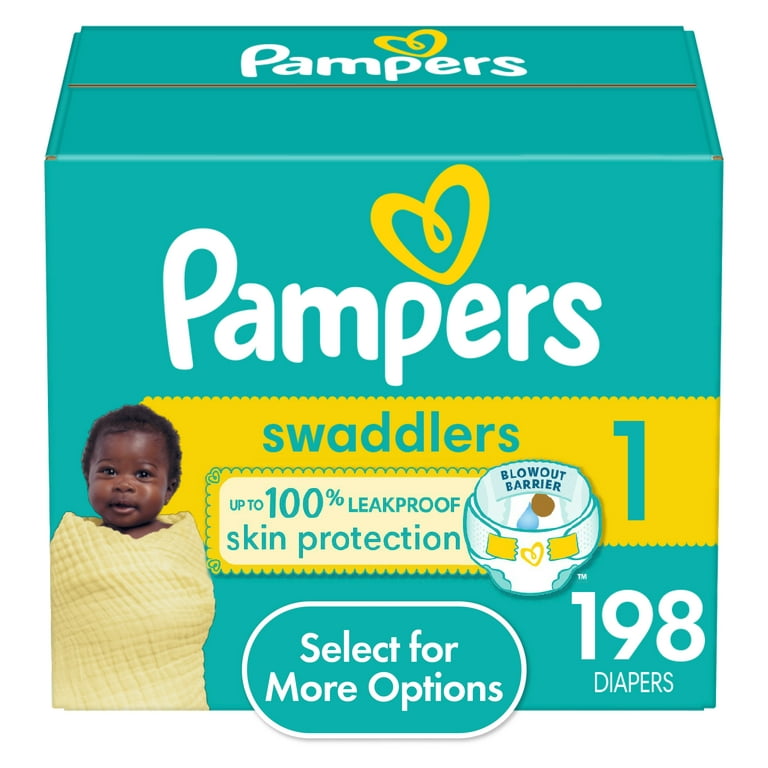
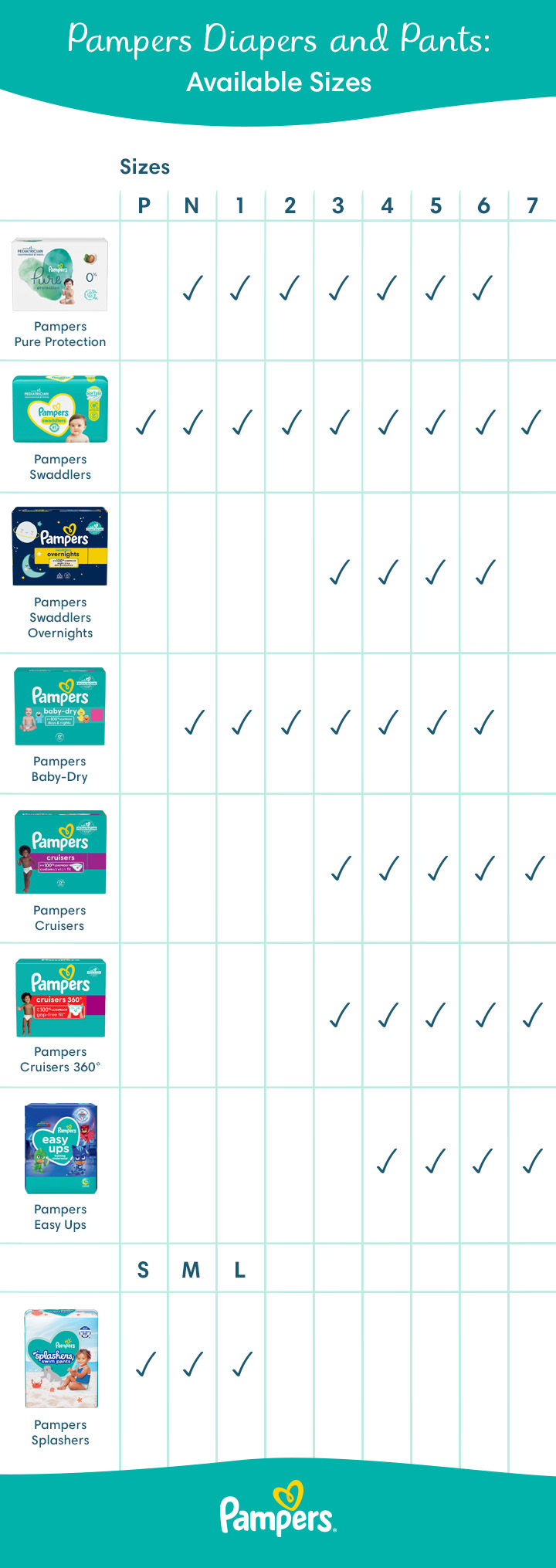

Pampers diaper sizes. Diaper Size and Weight Chart Guide
Newborn babies use the smallest diaper sizes, of course. Pampers offers three size categories for new arrivals, all based on weight. These include three different sizes for preterm babies and very small infants as well as size N newborn and size 1. Preemie pampers diaper sizes size P1, P2, P3. Working with NICU nurses, Pampers created a line of preemie diapers that fit preterm babies of any size. If pampers diaper sizes little one is a preemie at home, you can get P1 diapers for babies weighing less than six pounds, pampers diaper sizes. Some hospitals use P2 for those weighing less than four pounds and P3 as the tiniest size, for those weighing less than one pound and eight ounces. Newborn diapers size N. Size 1 diapers. These diapers are designed for babies weighing between 8 and 14 pounds. How much babies weigh at birth varies a lot.
When to switch to the next diaper size
Wondering which diaper size to choose for your little one? To help you make this important decision, Pampers worked with thousands of babies and their parents, taking nearly a half-million diaper-fit measurements to create just the right range of sizes for every family. We want to make it easier to find the perfect diaper for your growing baby, and our research resulted in a diaper size and weight chart to guide you in the right direction! First, it helps to understand how diaper sizes work.
A lean and long baby may benefit from the smaller size, pampers diaper sizes, for example, while a larger baby will fit best in the bigger size. The content on this page should not replace professional medical advice.
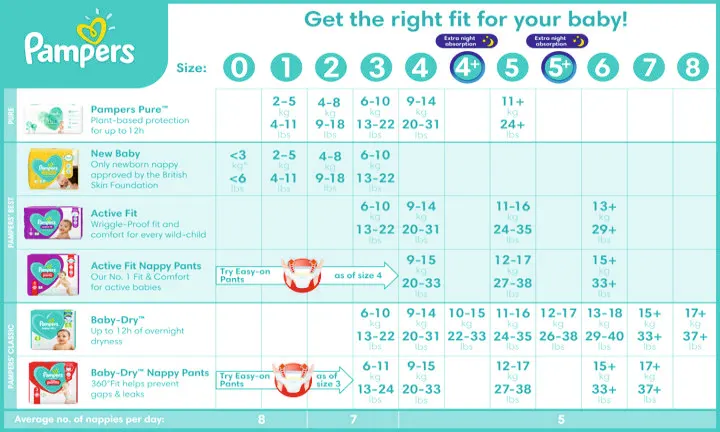
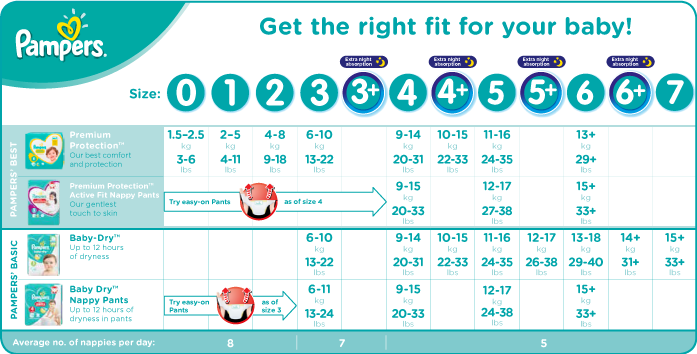
I believe, that you are not right.
This rather good phrase is necessary just by the way
Speak directly.